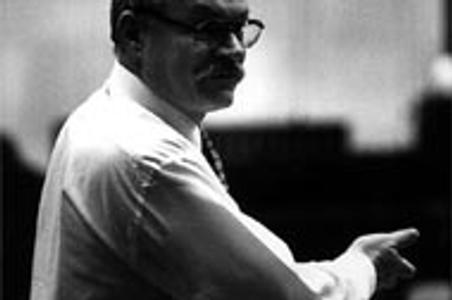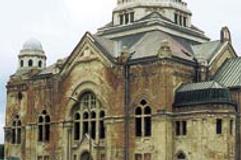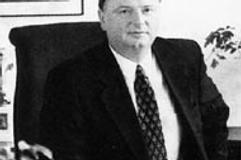Archive of articles - November 1997, page 4
If you desire to read an old article, use the search bar or select the publication date.
Planned meeting between EU country's parliamentary speakers, Slovak speaker cancelled after parliament's decision not to reinstate ousted MP.
The cancelled Bratislava summit of EU-associated countries' parliament speakers and the European Parliament's (EP) resolution that preceded it, may well be the first sign of Slovakia's growing international isolation according to the opposition.The two-day summit was supposed to take place in the Slovak capital on October 27. But Ivan Gašparovič, the Slovak Parliament's Speaker announced on October 21 that he had decided to cancel the event, because José María Gil-Robles, the EP Speaker, had announced in a letter that he would not participate."Gil-Robles summoned representatives of all EP factions [to hear their opinion]," said Jozef Migaš, chairman of the Party for Democratic Left who learned about the decision during his visit to Brussels one week before it was made official.
11 Slovak companies make Top 100 CE list
11 Slovak firms have made it into the 1996 list of the top 100 Central European companies, published by the international auditing firm Deloitte & Touche. Their standing brings both good news and bad news about the country's economy.The good news is that Slovakia, whose market size is half of Hungary's, squeezed in the same number of firms as its southern neighbor.The bad news, however, is that while Slovakia's presence on the list has increased from nine corporations in 1995, mostly due to Volkswagen's improved performance and VSŽ, which had two of its companies make the list, a majority of the listed Slovak firms recorded stagnant or declining performance figures for 1996 compared to the year before.
Rivers of Babylon
The film is a sarcastic parable about the unstoppable rise of an individual to power. It is a story about a simple but mysterious and brutal man named Rácz who rises from the bottom rung of the social ladder to the pinnacle of financial and political power.Rácz starts in a boiler-room of a big hotel in the capital city and makes his way through the urban underworld, emerging at last in high society. This backdrop provides dozens of eccentric, mad, dramatic, and tragic moments. The barrier between personal integrity and the schizophrenia of human beings and society is very unclear.
Gov't jacks VAT on press outlets
The government announced its plans to crack the whip on the independent press by jacking up the value-added tax for newspapers by 17 percent. This has prompted a warning from the Slovak publishers' association that the move will destroy the plurality of opinion in the Slovak media.The bill, approved by the government on October 21, proposes that the rate of tax on publications which devote more than 10 percent of content to advertising or erotic and pornographic material, would be increased from 6 percent to 23 percent.Most publishers fiercely opposed the move, saying that even a small increase in price would suffice to drive their less wealthy readers away. "It is an attack on the plurality of the press, because insolvent readers, especially pensioners, who form the largest group of subscribers, will simply be forced to give up their daily paper for economic reasons," said Miloš Nemeček, chairman of the Slovak Publishers' Association.
Central Passage to link with Stará Tržnica
With work on the exterior of Stará Tržnica complete and the interior scheduled to be finished this spring, another developer is planning to build on the success and forge a bond with Bratislava's old market hall.Devel s.r.o. has bought Central Passage, a five-storey building adajacent to Stará Tržnica, and plans to develop it into a multi-functional building that will draw people both to and from the reopened market next door.Ľudoviť Kaník of Devel said that Central Passage's 4,000 square meters of shops, offices, and perhaps even apartments will compliment the retail outlets of Stará Tržnica. He said he aims to connect the two buildings on two floors, thus creating "one complex with four entrances." "The influence of Stará Tržnica on our passage will definitely be positive. Opening Stará Tržnica will bring more people into the passage."
Jewish synagogues wait for interest and resurrection
Slovakia was a home to more than 70,000 Jews before War World II. Less than 3,000 of them survived the war. What has remained after all these years are the synagogues, Jewish houses of prayer, which have been left behind empty, in terrible shape waiting to be used again.There are approximately 120 synagogues still standing in one shape or another around the country. These buildings are what's left from the regime that tried to destroy them. During communism most of them were used as storage warehouses for agricultural or chemical products, some were made into movie theaters, or cultural centers, and most just hidden behind tall concrete walls.There are not enough Jews to use these Synagogues today and a new purpose hasn't been found for these giant landmarks. A small percentage of the synagogues are being reconstructed by the Slovak National Museum (SNM) and its Section on Jewish Culture, along with help from the Ministry of Culture, and by the Central Association of Jewish Religious Communities (ÚZŽNO).
The Spotlight
Air Force OneVolcanoMoney talksBeanBasquiat
Holy matrimony to bring parking
An unusual marriage, between religion and business, has been arranged to construct what promises to be one of the most intriguing multi-functional buildings in Bratislava's Old Town.The order of Saint Augusta of Notre Dame wanted to build a secondary school on a lot it owns between Jesenského and Palackého streets, across the street from the Slovak National Theater. The church owned this prime property, but lacked the financial means to develop it. It was for this reason that they rented the lot for 50 years to the newly-created joint-stock company Alexia Bratislava a.s., on the condition that the firm build a six-floor multi-functional center which would include a secondary school for nearly 300 pupils.
Toughest challenge for Mečiar
FINANCIAL TIMES, Tuesday, October 28, 1997Vladimír Mečiar, as prime minister, has dominated Slovakia since the state's birth almost five years ago, and faces his toughest challenge next year with opinion polls showing he has little hope of winning re-election against a resurgent opposition coalition.But it would be a brave observer who would bet on Mr. Mečiar's losing. Three times prime minister, he has been stripped of power twice, neither time at the ballot box, and he has always bounced back. He remains the country's most popular and masterful politician, with an instinctive grasp of rural nationalist opinion and a flair for political manoeuvring.
Drawing from the famous "well of love" at Trenčín Castle
"I will give you silver, gold, jewellery, precious Persian carpets...anything you desire," pleaded Omar, "only set my Fatima free!" "Everything you offer, we have already," sneered Štefan Zapoľa, the cruel Lord of Trenč'n castle. "And what does Your Highness not possess?" asked Omar."Water. Ordinary water," replied the Lord of the castle. "If you can find a plentiful source of water below this barren rock, your beautiful Fatima will be set free, and you will be given leave to return with her to your land." "I see that your heart is as hard as the rock on which your proud castle stands," said Omar quietly. "But I vow to show you that even this rock will yield to the power of love."Day and night thereafter, the constant impact of hammer and chisel clove the air. The Turks labored mightily on Trenčín's rock. They worked in six-hour shifts, day and night. No man rested. And Omar himself worked like a man possessed, wielding the massive tools for long stretches of time, his strength never flagging.
Mečiar and Kováč sign joint declaration
Despite the fact that the EU integration train appears to have rejected a whistle-stop in Slovakia, the Slovak government is still hoping to flag it down with a belated concession to EU political criticisms. With the crucial EU summit in Luxembourg only weeks away in December, Prime Minister Vladimír Mečiar and President Michal Kováč signed a joint declaration on October 16th affirming their mutual commitment to integration into the EU and western security structures.Though it was a concrete show of unity, it was a rather tentative one, and both EU parliamentarians and Slovak opposition politicians said that they wanted to see more than "lovely words." "Oral declarations are not enough for catching the integration train," said Jozef Migaš, leader of the Democratic Left Party (SDL'). "Concrete steps in the government and the Parliament must follow."
Anger and anxiety rule Romanies' lives in Slovakia
Peter Šarišský shares a forlorn brick house with ten other families on the outskirts of the eastern Slovak village of Letanovce. For five years, he has lived with his wife and four children in a tiny basement room without running water, toilets, central heating or telephone. For the last month, the electricity in the basement has been switched off. "What the hell, are we animals, that we should have to live like this?" he asked.Letanovce's squalid Romany settlement lies within a stone's throw of the protected area Slovenský Raj (Slovak Paradise). The heavy irony is not lost on Slovakia's Romany activists, who say that Gypsies, as Romanies have long been called in Europe, have never been accepted as equals by the country's white majority.
Capital market unphased by plummeting stock markets around it
Last week there was a sharp fall at neighboring stock markets triggered by the October 27 fall at the New York Stock Exchange, the largest in its history. The Dow Jones Industrials fell by more than 550 points and lost more than 8 percent of its value. U.S. investors reacted to the bursted bubble on the Asian stock markets, which have been in crisis since the devaluation of the Thai currency. Both European and World markets followed immediately and reported significant losses after the meltdown of the NYSE.However, the turmoil on international capital markets' did not spill over to Slovakia. On the contrary, the SAX index grew by a slight margin on October 28, the same day stocks in Poland dipped by almost 10 percent, the Hungarian BUX lost 16 percent of its value, and the Russian stock market fell by more than 20 percent.
World's best photography showcased this month all across Slovakia
The biggest photography exhibition of the year in Central and Eastern Europe kicks off November 8 at the Slovak National Gallery in Bratisava. The seventh annual "Month of Photography" brings 38 exhibitions of some of the world's finest photographers to towns all over Slovakia.The main star of this years' event is the American photographer Annie Leibowitz, famous for her portraits of celebrities and pictures from the Atlanta Olympics. Leibowitz will be present for the opening of her exhibition.The event already started unofficially in Košice, showcasing the works of the famous photographer Karol Divald, a native of Košice. Divald was one of the pioneers of photography in the late 19th century.
Incredibly enjoyable dining experience at Chez David
Growing up with Kosher food in Seattle was not my idea of fun. Even the few times I did touch animal meat, I found the food to be bland and tasteless. Chez David allows me return to my childhood but this time with a new fondness for Kosher cooking which I never thought was possible.Delicately breaded falafel, which lies on a carefully prepared bed of white pumpkin and is seasoned with fennel and dill, is difficult to refuse. Or the garlic soup, which is smooth as butter, or the salmon steak, which is by far the best in Bratislava. What is really nice about this place is the consistent service. The waiters speak English and are quite attentive, the tablecloths are changed after every diner leaves, you won't find an ashtray on the table unless you ask, and the food is outstanding.
Company Profile: Slovakofarma
For a company that started out in 1941 by producing morphine and its derivatives, Slovakofarma a.s. has grown into quite a giant in recent years. Today it is one of the top firms in Slovakia, especially regarding profitability and export performance. "Slovakofarma now ranks among the six largest pharmaceutical companies in Central and Eastern Europe," said Ondřej Gattnár, the 48-year-old general director.Slovakofarma manufactures more than 230 types of drugs which are classified into two categories, anatomical and therapeutic (ATC), which can be divided further into 18 groups. The largest portion of drugs is designed to treat cardiovascular diseases, and made up 31 percent of 1996 sales. The company's bestsellers are the well-known Agapurin and Alnagon tablets.
- Slovakia brings back border checks with Hungary and Austria starting April 8
- News digest: PM Fico questions Europe's rearmament
- Last Week: And then they came for the NGOs
- One of the biggest car makers enters Slovak market
- Parts of Bratislava to witness significant development in near future
- Local fuming over plans to burn waste near famous mineral springs
- Top 10 events in Bratislava for foreigners
- What abides: Giving a shit
- Slovakia brings back border checks with Hungary and Austria starting April 8
- Last Week: And then they came for the NGOs
- What abides: Giving a shit
- Parts of Bratislava to witness significant development in near future
- Foot-and-mouth outbreak hits major Slovak cattle farm near Austrian and Czech borders Photo
- News digest: Crisis, what crisis? Culture minister's empty limousine tours Europe
- Don’t be afraid to use cash, say entrepreneurs as transaction tax begins
- News digest: PM Fico questions Europe's rearmament
- Last Week: And then they came for the NGOs
- What abides: Giving a shit
- Slovakia brings back border checks with Hungary and Austria starting April 8
- Štítnik resumes hand-crafting Christmas ornaments after 25 years
- A partnership centuries in the making
- From Mexico to Slovakia – finding a new life Audio
- Strange romance: Slovak leaders’ affection for Russia has yo-yoed
- News digest: Crisis, what crisis? Culture minister's empty limousine tours Europe
- What abides: Giving a shit
- Last Week: And then they came for the NGOs
- Foot-and-mouth outbreak hits major Slovak cattle farm near Austrian and Czech borders Photo
- From Mexico to Slovakia – finding a new life Audio
- Slovakia brings back border checks with Hungary and Austria starting April 8
- Trading McDonald’s for the front lines
- A paper that wasn’t supposed to last
- Strange romance: Slovak leaders’ affection for Russia has yo-yoed
- Local fuming over plans to burn waste near famous mineral springs
- News digest: PM Fico questions Europe's rearmament
- Young Slovak ice-hockey sensation helps her team secure US title
- One of the biggest car makers enters Slovak market
- Parts of Bratislava to witness significant development in near future
- Last Week: And then they came for the NGOs
- Slovakia brings back border checks with Hungary and Austria starting April 8
- News digest: Crisis, what crisis? Culture minister's empty limousine tours Europe





